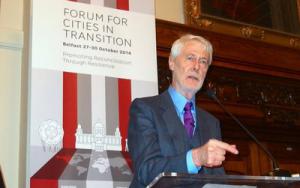IsraelIt’s too late for a two-state solution in Israel-Palestine
Many obstacles stand in the way of a two-state solution to the conflict in Israel and Palestine. The current wave of violence has cemented additional layers of distrust of Palestinians to the ones Jewish Israelis already harbor. The hatred is calcifying. Reaching a two-state solution is essential: Within a few years there will be more Palestinians than Jews “between the River and the Sea,” and without a Palestinian state, Israel will either have to give the right to vote to Palestinians or become an apartheid state like South Africa once was. Demographic changes taking place within Israel’s Jewish population, however, may make the implementation of a two-state solution, if it is miraculously agreed to by the two sides, impossible to implement. The most important structural change is that Israel is steadily becoming more religious, which is leading to a decline in the overall level of education and economic productivity of the Israeli population. Allied to the increasing propensity to religiosity among Israeli Jews are trends in the composition of the Israel Defense Forces (IDF), a change that raises questions about the reliability of the army. The IDF is increasingly a religious army, recruited from the settler community in the West Bank. Best estimates are that if a two-state agreement is somehow reached, about 100,000 settlers would have to be evacuated from the West Bank under any such agreement. Could the IDF be relied upon to evacuate Jerusalem and West Bank settlements — as they did in Gaza in 2005 — with battalion commanders who are increasingly religious, and with religious soldiers who, in any event, are more likely to obey their rabbis’ instructions than their commanders’ orders? With every passing year, using the IDF to evacuate settlers from the West Bank will become more problematic, and evacuation less likely — which means that reaching, and implementing, a two-state solution is becoming less likely as well.

Professor Padraig O'Malley, University of Massachusetts Boston // Source: umb.edu
Many obstacles stand in the way of a two-state solution to the conflict in Israel and Palestine.
At the moment, negotiations are a nonstarter for all parties.
Israeli Prime Minister Benjamin Netanyahu has only a razor-thin majority in one of the most right-wing Knessets in Israeli history. President Barack Obama has tossed the ball to his successor. Recently, accounts have emerged of the U.S. administration giving up on there ever being two states and beginning to focus on what a one-state solution looks like. And then there’s the ongoing violence in Jerusalem and the West Bank that has been called “a leaderless intifada.” This violence has cemented additional layers of distrust of Palestinians to the ones Jewish Israelis already harbor. The hatred is calcifying.
During the five years I spent researching the conflict in Israel and Palestine for my recent book, The Two-State Delusion: Israel and Palestine, it became increasingly clear that while talks over the past twenty-five years have focused on borders, settlements, Jerusalem and the right of return of refugees, demographic changes may have made the idea of a two-state solution obsolete even before such a solution could be worked out.
Much is made of the fact that within a few years there will be more Palestinians than Jews “between the River and the Sea.” Without a Palestinian state, Israel will either have to give the right to vote to Palestinians or become an apartheid state like South Africa once was.
As I report in my book, other demographic changes that have received little attention but may be of far more consequence are taking place within Israel’s Jewish population.
Population shifts
The birth rates of Haredim, or ultra-Orthodox Jews, and of Palestinian-Israelis exceed those of Orthodox and secular Jews.
This is creating some fundamental structural changes in Israel. Between 25 percent and 33 percent of Israeli schoolchildren now attend religious Haredim schools. These are schools where no math or science is taught. They graduate pupils with few of the skills necessary to live in the modern world.
The Bank of Israel concludes that unless the Haredim receive more higher education, Israel will fall from 16th to 26th among 34 member countries in the Organization for Economic Cooperation and Development (OECD).
Twenty years ago, 60 percent of Jewish Israeli children attended secular schools. Today, that number is 40 percent, and the trend shows no sign of leveling off.
With more religious education,
